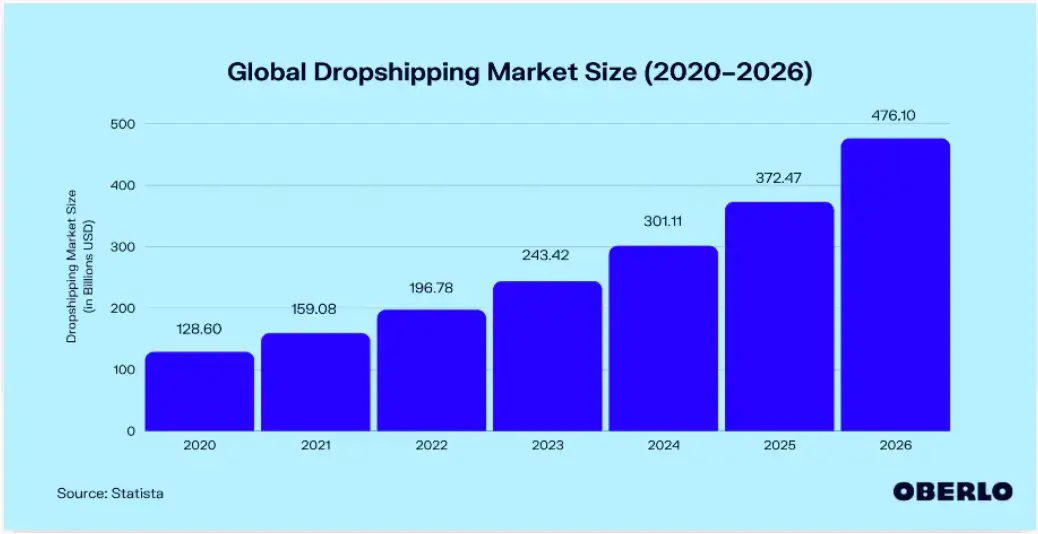Imagine a world where you can run a thriving business without worrying about inventory, warehousing, or shipping hassles. Sounds too good to be true, right?
Well, get ready to embrace the exciting realm of dropshipping – a business model revolutionizing how entrepreneurs around the globe reach customers and create successful ventures.
In today's interconnected world, building a dropshipping business has become more accessible than ever before.
The numbers speak for themselves: According to recent studies, the dropshipping market is projected to reach a staggering $476.1 billion by 2026.

This statistic alone showcases this dynamic industry's immense potential and lucrative opportunities.
However, like any business endeavor, embarking on a dropshipping journey has its fair share of challenges. From finding reliable suppliers to navigating international logistics, there are hurdles to overcome along the way.
But fear not! This article will guide you through the intricacies of building a successful dropshipping business, helping you seize the opportunities while effectively tackling your challenges.
Opportunities in Building a Dropshipping Business
- Access to a wide customer base
- Lower startup costs and reduced inventory management
- Flexibility and scalability
- Niche market targeting
1. Access to a wide customer base
With dropshipping, you hold the key to unlocking the doors to an unprecedented pool of potential buyers.
Gone are the limitations of a local market; you now have the power to reach customers in far-flung lands, crossing borders and transcending boundaries with a mere click of a button.

By embracing the vast customer base of dropshipping, you open the floodgates to a world of possibilities.
Moreover, by employing effective product launch strategies, you can significantly impact potential buyers. A well-executed launch generates buzz, anticipation, and sales, catapulting your dropshipping business to new heights.
Marketplace development is another growth aspect, expanding your presence across platforms to broaden your reach.
2. Lower startup costs and reduced inventory management
One opportunity that makes dropshipping so attractive is the ability to start your business with significantly lower costs and bypass the complexities of inventory management.
Traditional businesses require high upfront costs for stock and rent, but dropshipping eliminates these by letting you only pay once a sale is made.
Using inventory management tools and invoice financing helps you maintain cash flow and avoid excess stock.
Monitoring gross profit and margin ensures you track financial health, pricing effectiveness, and product profitability.
3. Flexibility and scalability
Flexibility allows quick responses to market changes, and scalability ensures easy expansion.

Scaling up your dropshipping empire is straightforward: add suppliers, expand niches, and grow with demand.
4. Niche market targeting
A niche market is a smaller, highly engaged audience. By serving them specifically, you can become the go-to expert.
For instance, you might start a print on demand business or brand your own coffee line.
Focusing on a niche builds trust and loyalty, allowing you to thrive in a “smaller pond” with dedicated customers.
Challenges in Building a Dropshipping Business
- Supplier and product sourcing
- Shipping and logistics complexities
- Competitive marketing and pricing pressure
- Customer service and communication
1. Supplier and product sourcing
Finding reliable suppliers is key. Clear expectations, communication, and performance standards are crucial.
Consider leveraging eCommerce platforms like Shopify to connect with trusted suppliers.
Read more about the eCommerce conversion funnel.
2. Shipping and logistics complexities
Shipping involves lengthy delivery times, customs clearance, and coordination across multiple carriers.

Freight forwarders and logistics systems help, but challenges like lost or damaged packages require robust systems and clear communication.
3. Competitive market and pricing pressure
Dropshipping is highly competitive. With many sellers, pricing pressure is inevitable.

Balancing competitive pricing while maintaining margins is like walking a tightrope. Quality, demand, and costs all factor into setting the right price.
4. Customer service and communication
Customer service and communication are essential.
Challenges include:
- Language and cultural differences → consider multilingual support.
- Time zone differences → use 24/7 support and chatbots.
- Logistics/delivery issues → keep communication transparent.
- Disputes/returns → have clear policies and handle complaints with empathy.
Strong service builds word-of-mouth marketing, trust, and loyalty.
Conclusion
Dropshipping empowers entrepreneurs to tap into global markets without inventory burdens or large startup costs.
However, perseverance and learning from challenges are key. With persistence, the right tools, and passion, success is attainable.

